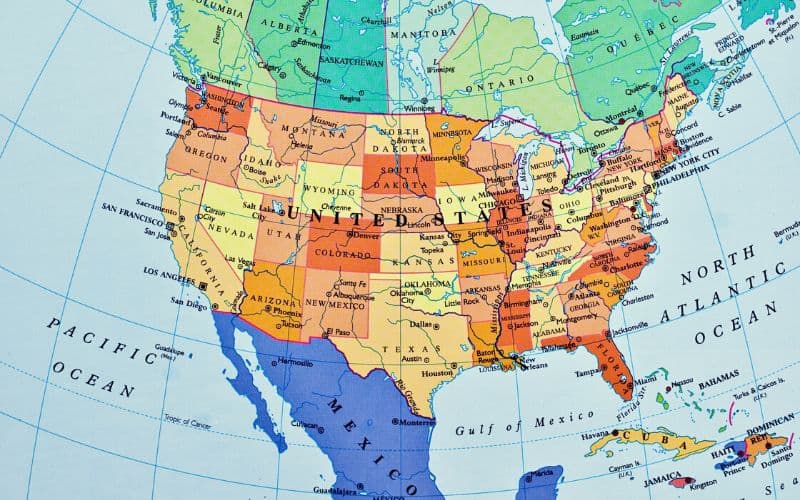For obvious reasons, being able to identify where you are when out in the backcountry can come in mighty handy.
Whether you’re navigating in low visibility, trying to figure out how far you have to go to your next camp, or calling emergency services after an accident, this skill is one every hiker and backpacker should have on their resume.
Depending on where you are in the world, to do this you’ll need a working knowledge of UTM coordinates. Below, we explain how to do so with a short and simple guide to the UTM System.
Table of Contents
- What Is A UTM Map?
- Why Is Learning To Read A Universal Transverse Mercator (UTM) Grid Reference Important?
- Latitude Longitude vs. UTM
- What is the State Plane Coordinate System?
- What is the Military Grid Reference System?
- How Do I Read A UTM Coordinate?
- How To Convert Between The UTM System Vs WGS84 Vs Longitude and Latitude?
- Happy Hiking!
What Is A UTM Map?
Universal Transverse Mercator projection (UTM) is a world geodetic system of map projection that treats the earth as a perfect ellipsoid. It was first devised by the US Army in the 1940s to simplify land navigation.
It is a grid system that divides the world into 60 strips (called “UTM projection”) divided by lines pointing to true north with separate grid zones for the northern and southern of the equator, giving a total of 120 UTM zones worldwide. The system is used to assign coordinates to locations on the Earth’s surface, using each zone as a basis for coordinate values.
Each UTM zone is numbered 1 to 60, beginning at 180 degrees longitude and increasing to the east. Each zone comprises 6 degrees of longitude and has a designated central meridian.
In each UTM grid zone, coordinates are measured in meters as “northings” and “eastings”. Northing values are taken by measuring northward from zero (at the equator).
Every zone also has a central meridian with an easting value of 500,000 meters. Zone 20, for example, spans from 66°W-60°W and has a central meridian of 63°W. If your position is 10 meters east of this central meridian, then you have a 500,020 meters easting. A northing of 3, 502,000 meters means you are this many meters north of the equator.
Many hikers prefer to use UTM over latitude and longitude coordinates when using 7.5-minute series topographic maps – all of which feature 1000m UTM grid tick marks – due to the simplicity of the decimal degrees.

Why Is Learning To Read A Universal Transverse Mercator (UTM) Grid Reference Important?
Being able to use a UTM map and read UTM values is important for three reasons.
First, it allows you to identify your exact whereabouts on a map using the coordinates given in a GPS device.
Secondly, it allows you to give rescue services your precise location should your trip in the backcountry go south and you need to call for help.
Thirdly, you don’t have to use negative value numbers (which make no sense to some people!). The central meridian is assigned an arbitrary value of 500, 000 meters to avoid negative easting coordinates. The equator is also assigned a false northing of 10,000,000m South to avoid negative numbers when referencing northing coordinates in the southern hemisphere.
Finally, UTM system grid references are easy to grasp and let you quickly determine your location. The simplicity of the system means that UTM maps are now becoming more popular than latitude-longitude maps that use the geographic coordinate system, so using UTM means you’ll be “on the same page” as fellow hikers and search and rescue teams.
Latitude Longitude vs. UTM
In the Universal Transverse Mercator coordinate system, each grid square is the same size and shape across the map. This isn’t the case with the geographic coordinate system, in which measurement units are not constant across the globe because the distances represented in degrees of longitude vary at different latitudes.
Because there’s no need for N, E, W, or S in UTM grid references, and because the UTM system allows you to calculate distances by adding or subtracting from other positions in the same zone, UTM makes it much easier to gauge the distance between two points and ascertain direction of travel than with the geographic system.
Scale factor, which is the ratio of the map’s scale in relation to the true distance in the terrain, is used to quantify distortion in map projections. The scale factor of the central meridian in each UTM zone is 0.9996, which means that there is minimal scale distortion within any given zone.

Working across zone boundaries (i.e. if hiking in an area that straddles two UTM zones), is trickier because distortion and error augment the farther you move from the zone for which the projection is set. To ensure accuracy in such situations, we recommend you cross-check readings by using another coordinate system.
To get around the zone boundary problem, some large-scale maps include the coordinates of the adjacent zones if a zone boundary is located within the area covered by the map. This, however, isn’t always the case.
What is the State Plane Coordinate System?
The state plane coordinate system (SPCS) is a variation of the UTM system in which each state has its own zone (or zones, depending on the size of the state). In this system, map projections also vary from state to state.
What is the Military Grid Reference System?
The Military Grid Reference System or MGRS is another variation of the UTM (Universal Transverse Mercator) that uses a two-letter identifier instead of the small digits used in the UTM zone/coordinate system to identify the 100,000 square.
How Do I Read A UTM Coordinate?
Locations in UTM must contain the following:
- A zone number (1 to 60)
- A zone hemisphere (N or S for Northern Hemisphere or Southern Hemisphere)
- An easting and northing
- When reading coordinates, your reading should state easting values first, then northings. A useful mnemonic to help you remember this is “along the corridor, then up the stairs.”
To take a coordinate reading:
- Start by identifying the UTM zone, which is a number from 1 to 60 and is located in the title block in the bottom left corner of USGS maps.
- Next, identify the hemisphere. This one is, of course, very simple – ‘N’ if you’re in the northern hemisphere, ‘S’ if you’re in the southern hemisphere.
- Now, read your easting. UTM map grid lines are spaced at 1 kilometer (1000 meter) intervals. As with geologic topographic maps, take your eastings from the vertical grid lines that run from grid north to grid south.
- Next, read your northing value. These can be taken from the horizontal grid lines that run east to west.
- On USGS maps, tick marks between grid lines are spaced at 100-meter intervals, so your coordinate values can now be identified with accuracy.

Let’s use the UTM reference of the Empire State Building as an example:
18 N 5 85 633 East 45 11 322 North
To unpack these numbers, we have to break the reference down into parts:
- 18 – The zone number
- N – The Northern Hemisphere
- 585633 – The measurement of the East-West position (“UTM easting”), within the Grid Zone, in meters. Using a map with 1000m gridlines, the first three digits come from the label for the grid line to the west of the position. The last 3 digits are the distance in meters measured from the western gridline
- 4511322 – The measurement of the North-South position (“UTM northing”), within the Grid Zone, in meters. Using a map with a 1000m grid, the first three digits come from the label for the grid line to the south of the position. The last 3 digits are the distance in meters measured from the southern gridline
How To Convert Between The UTM System Vs WGS84 Vs Longitude and Latitude?
If you want to change the format from UTM to or from another coordinate system, then we highly recommend you check out this UTM to latitude and longitude converter:
*Note we can not confirm the accuracy of any values the calculator generates.
Happy Hiking!
We hope the above guide has helped you get your head around the workings of the UTM system. If you have any questions or comments, drop us a line in the comments box below. And if you’d like to share this post with your pals, please do!

